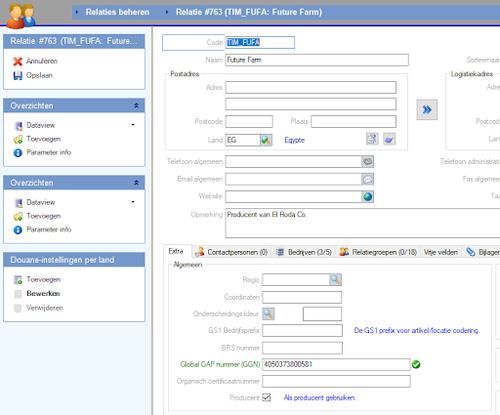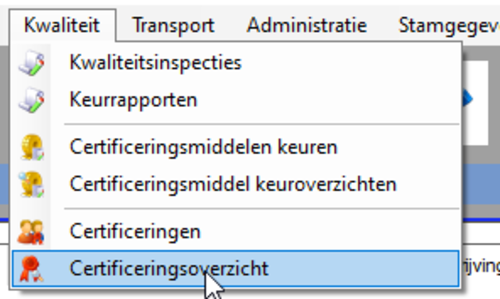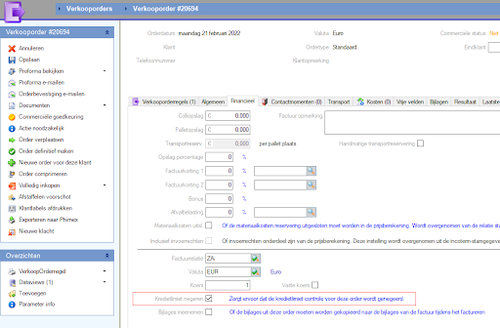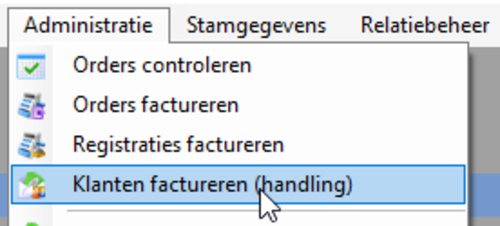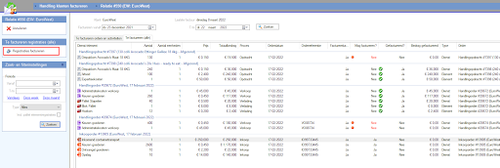Vanilla release
A new quarterly release for GreenCommerce will follow in the second quarter of 2022. This time we are approaching the end of the alphabet with the Vanilla version. It is not a mandatory version. The Vanilla release is mainly dominated by Quality Assurance & Compliancy and Service Providers themes. New developments for certifications and certificate management ensure better processing and more overview. Steps have also been taken in file structure and service invoicing. Read all release notes below:
Inspection/search function customs files
For the administration of stock of goods in transit in customs warehouses, it is required to keep a file. In this file it must be visible at all times what the current stock status is of a batch that has been received and stored in transit. A new screen has been developed in which the involved batches are shown on the basis of a reference.
Cost price per batch instead of average cost - Batch split
It has been made possible to make a specification of prices within one purchase order line. A user can record the specification for any purchase order line, provided that more than 1 batch 0belongs to a purchase order line. Once this has been carried out, the package price can only be managed via the grid in the pop-up. The functionality is not available for handling orders and when working with batch splitting.
Deactivate clearance control when finalizing sales orders
Characteristics of relation as producer
Link between supplier and producer
Managing Producer Certifications - Producers / Certification
When adding new certifications, an adjustment has been made that also makes it possible to select relations that are marked as 'Producer'. At the same time, the order of entries has been changed so that the fields are traversed in a more logical order.
In addition, an extra field has been added with which the certification number / registration number of a certification can be recorded. In this way, it is possible to structurally record which reference numbers are available.
For the following situations, a notification/warning is now also given for mandatory non-article-specific certifications:
- The supplier's mandatory non-article-specific certification has expired or
- The supplier has no mandatory non-article-specific certification and all mandatory non-article-specific certifications of the linked manufacturers have expired
A notification/warning is also given for article-specific mandatory certifications in the following situations:
- The supplier's mandatory article-specific certification has expired or
- The supplier has no mandatory article-specific certification for the article and all mandatory article-specific certifications of the linked manufacturers have expired
Insight into certifications of supplier incl. producers
A new menu item has been added to the [Quality] menu that displays certifications from suppliers and sub-producers.
Simultaneously with the addition of this new screen, the certification management screen has also been hit, adding an 'as of date' to limit the set of inactive certifications.
The screen is made up of two parts. The upper part shows all suppliers for which certifications have been found in the indicated filters. By selecting one of the suppliers, the bottom panel shows which certifications are linked to the relationship.
When working with the license to also maintain certifications for producers (see IS38099), additional insight can be provided into the underlying producers that belong to a supplier.
Release sales orders from credit limit and approve commercially
"To support the requested changes in the credit limit checking process, an additional feature has been added to a sales order that allows the credit limit check to be overridden. This function only becomes available when the parameter “WorksWithAdjustableCreditLimitCheckPerCustomer” is turned on.
As soon as credit limit checks are used and it has been specified for a specific order that the limit may be ignored, the check on disposable space is not performed. As soon as an order line is moved to, for example, another order line for another customer or where a different credit limit check is set (ignore/don't ignore), the credit limit check is still performed.
To ensure that orders placed in the system cannot yet be processed further in the logistics process, an extension has been added that allows an order to default to status 'Not approved'. During the planning of shipments, the logistics status of the underlying sales orders is then checked. This is taken from the div. screens in which shipment schedules can be made."
Record Grower Identification at location
In order to improve the insight into price agreements made, a different approach has been chosen. The underlying reasoning is that it is desirable to have a clear screen insight into all active price agreements for a customer, just as you can do this from the trading process for a price list.
It starts from a screen with customers for which handling is being processed. Active price agreements for services are displayed in a panel based on a reference date that you can select yourself. It is also possible to easily link new services to relations, and/or to change service prices in a simple way. By means of the reference date, it is also possible to 'prepare' for, for example, the new season or new rates that must take effect from a certain date.
Record MRL registrations - Producers / Certification
A new menu item has been added to the [Quality] menu to manage MRL registrations. With an MRL registration, the following information is recorded:
- Registration date
- Executive relationship (the lab, e.g. Groen Agro Control)
- Producer
- Producer location (based on identification code [PUC / grower code])
- Validity period (for internal use)
- Remark
- Exceedance found (yes/no).
When registering, attachments can also be added so that documentation is quickly available.
The entered MRL data is then made available per producer in the certification overview (38100).
Managing certifications behind separate task
A new task has been added “Manage Certification” that can manage whether a user has permissions to add, edit or delete a certification.
Additionally, for users who do not have sufficient rights, the management within a certification itself is disabled and it is only possible to view attachments.
Note: When updating the application, this task is added once for all users who also have the “Activate certification” role.
Registering files with purchase order
Open file from purchase order - File Structure
Overview of files and detail of file - Dossier Opbouw
A new menu item has been added that allows you to view open files. For each file you can click through to a details screen in which div. tabs information about the goods, the status of activities and all registered services/elements is displayed.
The status of all linked batches is shown in the parties overview. These are both purchased and produced batches. In the [Activities] tab, the status of the div. activities displayed. Support is currently provided for inbound, production and outbound. In the [Registrations to be invoiced] tab, all service and element registrations that are billable are displayed. On the basis of the order (the activity), a registration can or cannot be invoiced.
Linking files to production batch
Insight into service/element registrations per file
In a separate tab in the file it is made clear which service and element registrations have been booked for activities related to parties from the file (purchase order, assignment, lot, sales order, sales order line, shipment).
To keep the screen clear, a grouping has been applied to the 'activity' (order). Among other things, the services/elements that have been posted on sales order lines and shipments are included in the corresponding sales order.
Disable periodic services on pallets - Service Providers
Suggestie datums TO o.b.v. laad- en losdatum inkooporder
If all lines in the freight order are of type 'Purchase', the earliest shipment date time of the lines is now used as the shipment date in the freight order. In all other cases, the current functionality continues to apply (the earliest shipment date time of the lines, its time and date of the transport request).
Aanvullende gegevens per mutatie t.b.v. extra inzicht bij terugmelden
With a batch mutation, three new columns have been added that show the information below. The amounts are always shown in the system currency. These can be made visible via the column selector. The columns are called:
- FeedbackSubTotalColliStorageObject
- FeedbackSubTotalPalletStorageObject
- ReportGrossRevenueObject
Invoicing from customer overview - ServiceProviders
Align filter: Production-, Inbound-, and Outbound confirmations
Make SSCC Label Best Before Date Adjustable
Sometimes it is not desirable to show the 'best before date (best before date)' on an SSCC label. That is why a setting has been added in the 'Relation master data' on the 'Communication' tab in the 'SSCC label' group that indicates whether the 'best before date' should be hidden on the SSCC label. When checked, the 'best before date' will be hidden on the SSCC label.
Billing overview per customer - from orders
Invoice order(s) and activities - Service Providers
Billing Registrations - Service Providers
All registrations are visible on the second tab from the customer overview. By selecting a number of lines, you can choose to invoice these registrations separately.
After the choice, the option is offered to fill in a manual invoice description. For example, for invoicing activities of a certain period.
Sales requirements
The Vanilla version provides a first basis for functionalities that can be managed by customers (or customer groups or markets). Here it is possible, among other things, to manage which certificates are required for goods that may be delivered. When creating sales orders, a sales requirement can be linked so that you as a user are flexible in determining the requirement per sales order (depending on the final destination).
During stock sales, it is possible to activate a filter with which suitable stock can be highlighted. As an employee you can quickly see which batches meet the sales requirements of a sales order.
In addition, it is possible to add a whitelist or blacklist of producers (or GGNs) to these sales requirements. This applies an additional filtering to the batch inventory that can be used to determine the suitability of a batch even more specifically.
Recording certificates at batch (based on supplier and GGN)
In order to respond to the need to provide insight into certain certificates at batches, functionality has been added to quality certificates. With this it can be set that batches are provided with the supplier certificates (in the case of purchasing), or a party can be independently provided with certificates (eg interesting for service providers). This information about batch certificates is then available in all screens where batch stock is displayed.
Er zijn geen release notes met dit label gevonden.
